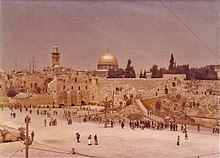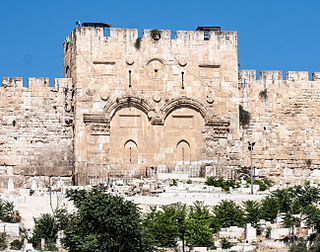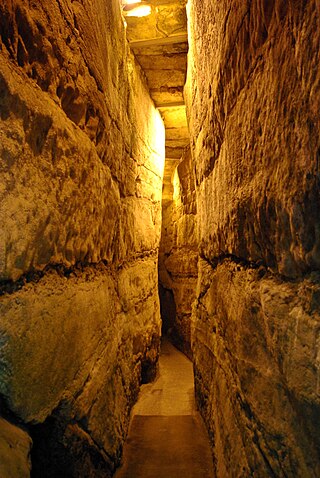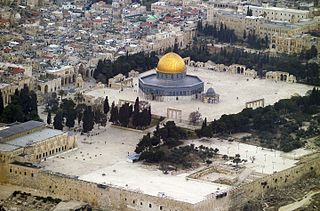
The Mughrabi Bridge is a wooden bridge connecting the Western Wall Plaza with the Mughrabi Gate of the Temple Mount in Jerusalem.

The Mughrabi Bridge is a wooden bridge connecting the Western Wall Plaza with the Mughrabi Gate of the Temple Mount in Jerusalem.

Until 2004 an earthen ramp allowed non-Muslim visitors direct access to the Temple Mount through the Mughrabi Gate. An 800-year-old wall holding back part of the hill jutting out from the Western Wall leading up to the Mughrabi Gate partially collapsed. Authorities believed a recent earthquake may have been responsible. [1] [2] During the winter of that year heavy snowfall (by Israeli standards) caused the ramp to collapse.
In 2007, the current wooden bridge was built, originally intended as a temporary measure that would stand for several months until a more permanent bridge was constructed. In order to build a permanent bridge, the remains of the old ramp and the earth under it had to be excavated, which resulted in accusations by the Waqf that Israel was trying to destabilise the Temple Mount and collapse the Dome of the Rock –400 metres (1,300 ft) from the location of the ramp –which in turn resulted in international criticism, violent protests and calls for a third Intifada. [3] Several of the neighbouring Arab states argued that the work threatened their internal stability, while other states threatened war. [4]
As a result, the bridge was still standing at the end of 2011, when the city engineer of Jerusalem issued an order to close the structure because it was not safe. [3] In 2012 and 2013, the support scaffolding of the bridge was replaced with a large metal beam structure and the area under the bridge was again open for visitors to walk around, resulting in a 1.5–2× increase in size of the Western Wall's women's prayer area (but not greater than the original area prior to construction).
In August 2014, construction was started on a second bridge to the Mughrabi Gate. The second bridge would be a supplement to the 2007 Mughrabi Bridge. [5] This secondary bridge became controversial, and at the wishes of the Jordanian government, work was halted and what had been built was torn down. [6]
The Mughrabi gate is the only gate to the Temple Mount that the Waqf allows non-Muslims to use for visiting the Temple Mount complex. [7] [8] The bridge is the only way to reach the gate.
The bridge and excavation of the historic ramp leading up to the gate have been a point of contention contributing to the hostility of the Arab–Israeli conflict. [9]

The Temple Mount, also known as Haram al-Sharif, al-Aqsa Mosque compound, or simply al-Aqsa, and sometimes as Jerusalem's holyesplanade, is a hill in the Old City of Jerusalem that has been venerated as a holy site in Judaism, Christianity, and Islam for thousands of years.

The Aqsa Mosque, also known as the Qibli Mosque or Qibli Chapel, is the main congregational mosque or prayer hall in the Al-Aqsa mosque compound in the Old City of Jerusalem. In some sources the building is also named al-Masjid al-Aqṣā, but this name primarily applies to the whole compound in which the building sits, which is itself also known as "Al-Aqsa Mosque". The wider compound is known as Al-Aqsa or Al-Aqsa mosque compound, also known as al-Ḥaram al-Sharīf.

The Western Wall, known in the West as the Wailing Wall, and in Islam as the Buraq Wall, is a portion of ancient limestone wall in the Old City of Jerusalem that forms part of the larger retaining wall of the hill known to Jews and Christians as the Temple Mount. Just over half the wall's total height, including its 17 courses located below street level, dates from the end of the Second Temple period, and is believed to have been begun by Herod the Great. The very large stone blocks of the lower courses are Herodian, the courses of medium-sized stones above them were added during the Umayyad period, while the small stones of the uppermost courses are of more recent date, especially from the Ottoman period.

The Old City of Jerusalem is a 0.9-square-kilometre (0.35 sq mi) walled area in East Jerusalem.

The Golden Gate or Gate of Mercy is the only eastern gate of the Temple Mount, and one of only two Gates of the Old City of Jerusalem that used to offer access into the city from the East side.

The Mughrabi Quarter, also known as the Maghrebi or Moroccan Quarter was a neighbourhood in the southeast corner of the Old City of Jerusalem, established in the late 12th century. It bordered the western wall of the Temple Mount on the east, the Old City walls on the south and the Jewish Quarter to the west. It was an extension of the Muslim Quarter to the north, and was founded as an endowed Islamic waqf or religious property by a son of Saladin.

The Jewish Quarter is one of the four traditional quarters of the Old City of Jerusalem. The area lies in the southwestern sector of the walled city, and stretches from the Zion Gate in the south, along the Armenian Quarter on the west, up to the Street of the Chain in the north and extends to the Western Wall and the Temple Mount in the east. In the early 20th century the Jewish population of the quarter reached 19,000.

Al-Marwani Mushalla, or Al-Marwani Mosque, is an underground vaulted prayer hall in the Al-Aqsa mosque compound in Jerusalem. It is 600 square yards in area, and is located under the southeastern corner of the compound, 12.5 m (41 ft) below the courtyard, and features twelve rows of pillars and arches. In December 1996 the Jerusalem Waqf renovated the area. The area was known to the Crusaders as Solomon's Stables, and to earlier Muslims as the Old Mosque.

The Western Wall Tunnel is a tunnel exposing the Western Wall slightly north from where the traditional, open-air prayer site ends and up to the Wall's northern end. Most of the tunnel is in continuation of the open-air Western Wall and is located under buildings of the Muslim Quarter of the Old City of Jerusalem. While the open-air portion of the Western Wall is approximately 60 metres (200 ft) long, the majority of its original length of 488 metres (1,601 ft) is hidden underground. The tunnel allows access to the remainder of the Wall in a northerly direction.

The Huldah Gates were one of the Gates of the Old City of Jerusalem leading into the Jerusalem Temple compound in the Hasmonean period and were named as such in the Mishnah. The term is currently being used for the remains of two later sets of gates, the Triple Gate and the Double Gate, known together as the Huldah Gates, built as part of the much extended Herodian Temple Mount, situated in Jerusalem's Old City. Both sets of gates were set into the Southern Wall of the Temple compound and gave access to the Temple Mount esplanade by means of underground vaulted ramps. Both were walled up in the Middle Ages.

The Temple Mount, a holy site in the Old City of Jerusalem, also known as the al-Ḥaram al-Sharīf or Al-Aqsa, contains twelve gates. One of the gates, Bab as-Sarai, is currently closed to the public but was open under Ottoman rule. There are also six other sealed gates. This does not include the Gates of the Old City of Jerusalem which circumscribe the external walls except on the east side.

A number of archaeological excavations at the Temple Mount—a celebrated and contentious religious site in the Old City of Jerusalem—have taken place over the last 150 years. Excavations in the area represent one of the more sensitive areas of all archaeological excavations in Jerusalem.

The Jerusalem Waqf and Al-Aqsa Mosque Affairs Department, also known as the Jerusalem Waqf, the Jordanian Waqf or simply the Waqf, is the Jordanian-appointed organization responsible for controlling and managing the current Islamic edifices on the Temple Mount in the Old City of Jerusalem, known to Muslims as Al-Aqsa, which includes the Dome of the Rock. The Jerusalem Waqf is guided by a council composed of 18 members and headed by a director, all appointed by Jordan. The current director of the Waqf, since 2005, is Sheikh Azzam al-Khatib.

Robinson's Arch is the name given to a monumental staircase carried by an unusually wide stone arch, which once stood at the southwestern corner of the Temple Mount. It was built as part of the expansion of the Second Temple initiated by Herod the Great at the end of the 1st century BCE. Recent findings suggest that it may not have been completed until at least 20 years after his death. The massive stone span was constructed along with the retaining walls of the Temple Mount. It carried traffic up from ancient Jerusalem's Lower Market area and over the Tyropoeon street to the Royal Stoa complex on the esplanade of the Mount. The overpass was destroyed during the First Jewish–Roman War, only a few decades after its completion.

The Islamization of Jerusalem refers to the process through which Jerusalem and its Old City acquired an Islamic character and, eventually, a significant Muslim presence. The foundation for Jerusalem's Islamization was laid by the Muslim conquest of the Levant, and began shortly after the city was besieged and captured in 638 CE by the Rashidun Caliphate under Umar ibn al-Khattab, the second Rashidun caliph. The second wave of Islamization occurred after the fall of the Kingdom of Jerusalem, a Christian state that was established after the First Crusade, at the Battle of Hattin in 1187. The eventual fall of the Crusader states by 1291 led to a period of almost-uninterrupted Muslim rule that lasted for seven centuries, and a dominant Islamic culture was consolidated in the region during the Ayyubid, Mamluk and early Ottoman periods. Beginning in the late Ottoman era, Jerusalem’s demographics turned increasingly multicultural, and regained a Jewish-majority character during the late-19th and early-20th centuries that had not been seen since the Roman period, which largely ended the Jewish presence in the region.
The Western Wall Heritage Foundation, often mentioned as the Western Wall Foundation, is the body responsible for administration for all matters concerning the Western Wall in Jerusalem. The group is made up of mostly ultra-Orthodox (Haredi) Jews and operates under the auspices of the office of the Prime Minister of Israel and the Government Companies Authority. Rabbi Ilan Cohen previously served as the Foundation's Chairman, and the position is currently held by Rabbi Shmuel Rabinovitch.

The Dung Gate, also known in Arabic as the Silwan Gate and Mughrabi Gate, is one of the Gates of the Old City of Jerusalem. It was built as a small postern gate in the 16th century by the Ottomans, first widened for vehicular traffic in 1952 by the Jordanians, and again in 1985 by the Israeli authorities. The Dung Gate is a main passage for vehicles coming out of the Old City and for buses headed to the Western Wall.

Temple Mount entry restrictions are restrictions on entering the Temple Mount, also known as Al-Aqsa Mosque compound, in East Jerusalem's Old City, which is a holy place for Muslims, Jews, and Christians. At present, the Government of Israel controls access to the site, which is an Islamic religious endowment under the management of the Jordan-based Jerusalem Islamic Waqf. There are entry limits to the Temple Mount for political and security reasons. In addition, Jewish religious law imposes restrictions on religious Jews on entering the compound.

The Western Wall Plaza is a large public square situated adjacent to the Western Wall in the Jewish Quarter of the Old City of Jerusalem. It was formed in 1967 as a result of the razing of the Mughrabi Quarter neighborhood at the very end of the Six-Day War.

On 15 April 2022, clashes erupted between Palestinians and Israeli Security Forces on the Al-Aqsa Compound in the Old City of Jerusalem. According to the United Nations Special Coordinator for the Middle East Peace Process, the clashes began when Palestinians threw stones, firecrackers, and other heavy objects at Israeli police officers. The policemen used tear gas shells, stun grenades and police batons against the Palestinians. Some Palestinians afterwards barricaded themselves inside the Al-Aqsa Mosque and proceeded to throw stones at the officers. In response, police raided the mosque, arresting those who had barricaded themselves inside. In addition, some damage was done to the mosque's structure.